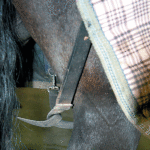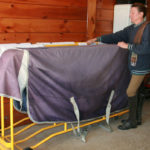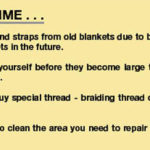Without question, when possible, we forgo blanketing. A horse who has never been blanketed probably won’t need to be, unless you clip him. For the most part, thick coats insulate horses from the cold, however even wooly horses may need a blanket, due to age, illness, injury, or a change in shelter. For these times, we have a lightweight turnout on hand. It’s still waterproof and breathable (How can you tell if a blanket is truly breathable? Blow through the material. You should be able to feel your breath on the other side if it is breathable). Remember, common sense prevails. If your horse is shivering, he needs help.

Factor in wind chill when deciding how heavily to blanket your horse. If it’s a particulary warm winter day, maybe a waterproof/breathable rain sheet will do the trick. Over blanketing is as bad as under blanketing.
Be aware that even horses in a perfect blanket with the best possible care can get rubs. Prevention is key:
Cleanliness. Dirt will exacerbate a rub, as it is abrasive and it can cause the fabric to become stiff and scratchy.
We recommend you purchase two winter blankets —so one can be washed while the other is on the horse. Our favorite washing solutions are Leather Therapy’s Saddle Pad & Blanket Wash and Union Hill’s Lettia Rain (we really couldn’t see a difference). The most cost effective (Best Buy) choice is JM Saddler’s Saddler’s Blanket Wash. It’s a cream, and a little bit goes a long way. Plus, it can be used as a spot pre-treatment.
Overall fit. Blankets that are too tight will cause rubs. Rubs can occur almost anywhere, especially if it’s a dirty blanket, but the main rub areas are shoulders, hip, chest, and withers.
Shoulder rubs are usually due to a blanket being too short or too tight. The friction from moving against the tight fabric causes the rub. He needs to be able to lower his head freely. If not, you need a bigger blanket, preferably with a Lycra shoulder guard.
Withers rubs are a nuisance, as they heal slowly. Avoid them by looking for a well-fitted blanket with soft padding/fleece in this area and be sure to reposition them frequently. Watch for any signs of hair rubbing, so you can catch it before it removes the hair.
While you might get away with skipping a day here or there, for the most part we take the blanket off each day, brush/curry the horse, and reposition the blanket.







